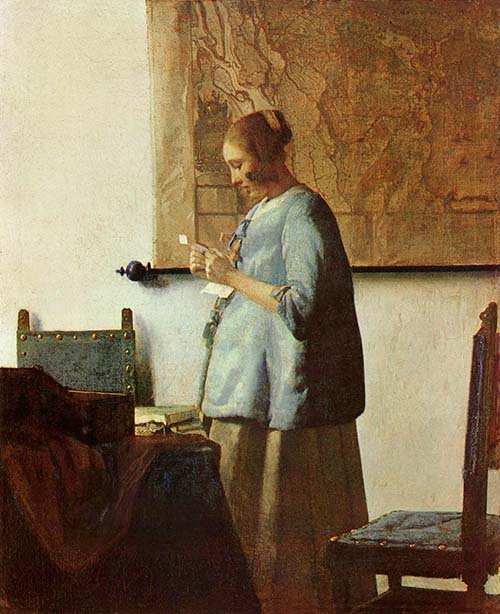Some Masterpieces from the Public Domain
Version 1.0, © 2009 by Dale Cotton, all rights reserved
Vermeer
Wikipedia entry for Vermeer
Prior to this exercise I simply enjoyed basking in Vermeer's light. Living with good reproductions for a few days has been a bit of an eye-opener. I now find Jan's draftsmanship, however accurate, to be a bit graceless. Where he excels is in rendering the subtle quality of illumination.
Each time I witness an exhibit of amateur oil paintings I'm reminded anew just how difficult a medium this is to control. The trick is to make the paints do your bidding, not vice versa; few artists reach that level, and fewer still soar above the inherent difficulties. The debate continues whether Vermeer used a camera obscura. My instinct is that he did; simply because his paintings show us the true genius of colour photography: capturing the subtle and evanescent beauty of the world that rarely holds still long enough to capture in paint.
Not just Vermeer, but the whole "school" of 17th century bourgeois Dutch painting of which he was a part, is also valuable to photographers in reminding us that great images can spring from humble subject matter.
In struggling with Woman in Blue, Figs. 2-2 and 2-3 on the Digital restoration page show my quandary. Here is the compromise I've settled on; my best guess as to what the actual colours must be. This interpretation is not only influenced by Fig. 2-3, it also looks to Fig. 4-3 and other Vermeers, so many of which depict the same room in his home in which Woman in Blue is reading. The flesh colour is still on the ochre side, but at least believable, given the warmth of the low sun angle.
I had a similar conflict with the pallet of this image, since there is both a warm+over-saturated and a cool-hued version of this image on line. The pleasantness of the skin colour after colour-correcting for other problems is my best assurance I'm on the right track. It's the particular blue of her head wrap that I find most doubtful:
The original scan file from which I worked for The Art of Painting is much more authoritative, so there was little to argue with regarding colours. Other problems, but not colour.
This painting, incidentally, has a story behind it. There is evidence Vermeer hung on to it in spite of offers to buy, presumably because he felt it was his masterpiece and wanted to have it around to impress prospective clients. He died in debt, but this picture was the one thing his widow struggled mightily to hang on to. That fact rhymes with the persistent belief that Vermeer painted himself as the painter in the picture, which could have been done using a couple of large mirrors. It also seems likely that the girl holding the trumpet was his eldest daughter and is also the same person we see in Fig. 4-2.


